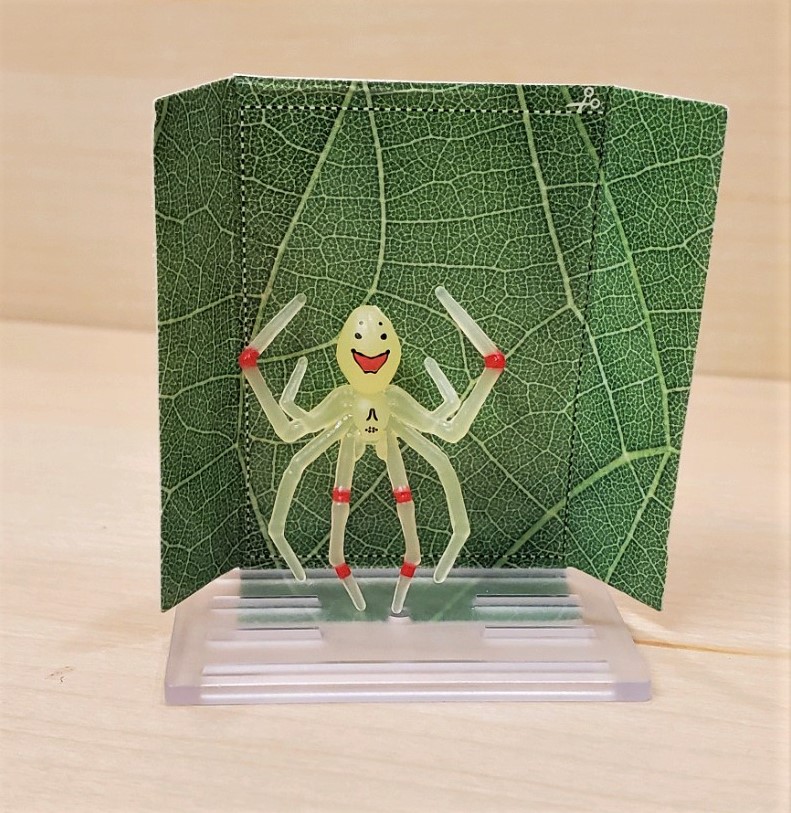Today I am reviewing an ingenious collection of spiders by Toy Spirits. The collection is called 3D Picture Book Spiders of the World. The verbiage ‘3D Picture Book’ (or similar) is used often in Japanese figures, most notably by Yujin, but this time it is very appropriate, as the figures come displayed in small books (more on that below). The collection just came out earlier this year, but has a copyright date of 2018, which makes me think this might be a re-release (and based on a typo on one of the boxes, the 2018 edition may have had a different species composition!). All five figures are identified by their Latin names in the books and from what I can tell, three of them are new/unique in toy form (and the other two have been made less than five times).
The set containes five small paper boxes designed like little books. Each is itself a strap figure that can be also worn on a keychain. Within the book is biological information and a mini diorama on which to display the spiders (I will do a step-by-step reveal below). The spiders themselves are a good quality PVC. While they may appear somewhat stylized due to their small size, they are accurately painted both dorsally and ventrally. They vary in total length (including appendages) between 3-4 cm.

First a look at the closed book and the acrylic base (for displaying the final product, if desired):

Next, open the book revealing the first page (on the right), which has the spider’s Latin and Japanese names, an image of the species, and, in Japanese, the maximum body lengths for male and female spiders, geographic distribution, and ecology:

Flip that page, and the next page has another photograph of the spider with additional information in Japanese. On the right, the plastic figure is enclosed in what will become the background of the mini diorama with an acrylic cover:

This next image shows the liberated spider, diorama background, and acrylic base:

Now that we have seen the overall presentation, let’s look at the individual species. There are multiple ways to display the final product, depending on how the diorama background is cut and folded. I am photographing them with their backgrounds here for this Blog review, but I am unsure I’ll display them that way on my shelves.
Mexican red-kneed tarantula, Brachypelma hamorii
There is confusion to the identity of spiders referred to as Mexican red-knees. Historically, they were known as Brachypelma smithi until the description of a cryptic species, B. hamorii, in 1997. The two species are indistinguishable morphologically and can only be separated by DNA barcoding and strict geographic distribution. Unless a figure is specifically marketed at the species level, I would traditionally assume it’s B. smithi. However, this figure we are seeing today was specifically marketed as B. hamorii, probably the very first to have been done so! The two species are geographically separated by the Balsas River in Mexico, with B. hamorii found on the north side of the river in the states of Colima, Jalisco, and Michoacán. Its natural habitat is deciduous tropical forests. The figure measures 4.0 cm in total length. The body length (excluding appendages) is 2.2 cm for a scale of 1:2.4 for a mature female.

Redback spider, Latrodectus hasselti
This species is native to Australia but has been introduced to New Zealand, Southeast Asia, and Japan. Like other members of the genus Latrodectus, it is venomous to people. Total figure length is 4.0 cm. Body length (minus appendages) is 1.5 cm for a scale of 1.5:1. Having been made three other times, this is surprisingly the best-represented species in this set!!! The other three are by K&M International, Science & Nature, and Takara Tomy A.R.T.S.

Adanson’s house jumper, Hasarius adansoni
Believed native to Africa and the Middle East, this species now occurs throughout much of the world in warmer climates, including the Americas, Europe, India, Laos, Vietnam, China, Japan, Australia, and the Pacific Islands. Being an anthropophilic species, it gets around easily, probably on introduce vegetation in gardens and greenhouses. Total figure length 3.5 cm. Body length (excluding appendages) 2.0 cm for a scale of 2.5:1. This is the second representative of this specie in toy form, the other being by Kaiyodo.

Jorō spider, Trichonephila clavata
Native to Southeast Asia and Japan, this species has been introduced to and is established in the Southeastern United States. Total figure length 4.0 cm. Body length (excluding appendages) 1.5 cm, slightly under 1:1 scale for a small female (normal body length 1.7-2.5 cm). This species appears in Japanese folklore as the Jorōhumo, a shapeshifting creature that can turn from a spider into a beautiful woman. As a human woman, Jorōhumo seduces men, binds them in her silk, and then devours them!

Hawaiian happy-face spider, Theridion grallator
This is the species I was probably most excited for, and honestly I have been secretly wishing for years Safari Ltd. would introduce one in their Incredible Creatures line. As the common name suggests, this species is endemic to the Hawaiian Islands where it lives in wet forests. It is usually found on underside of plant leaves. It gets the other half of its common name from the distinctive smiling face-like design on the abdomen. Total figure length 3.1 cm. Body length (excluding appendages) 1.4 cm for a scale of 2.8:1.

Whether or not you like the presentation, this set offers a chance to get several unique or very rarely made spider taxa. It comes highly recommended for collectors of interesting taxa. On or off the diorama bases, they also take up very little space and on the dioramas they have good shelf presence.
Disclaimer: links to Ebay and Amazon on the AnimalToyBlog are affiliate links, so we make a small commission if you use them. Thanks for supporting us!



